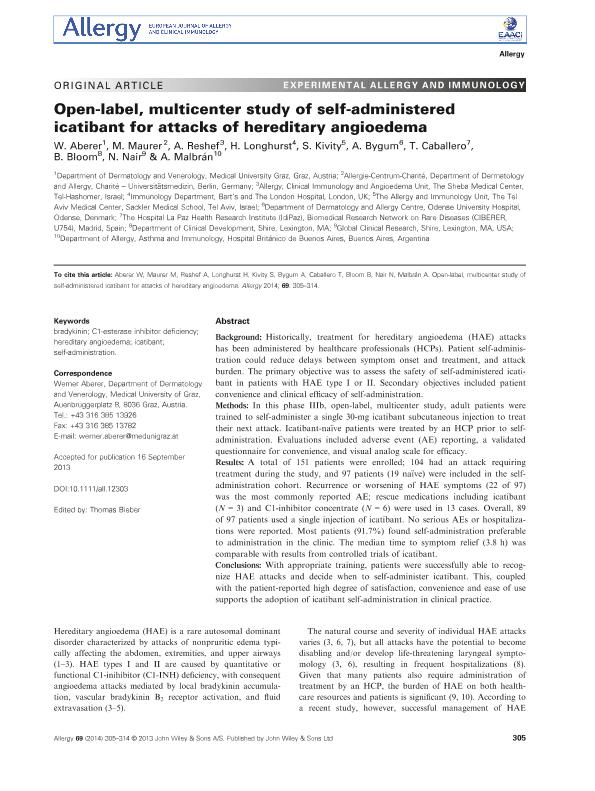Artículo
Open-label, multicenter study of self-administered icatibant for attacks of hereditary angioedema
Aberer, W.; Maurer, M.; Reshef, A.; Longhurst, H.; Kivity, S.; Bygum, A.; Caballero, T.; Bloom, B.; Nair, N.; Malbrán, Alejandro

Fecha de publicación:
03/2014
Editorial:
Wiley Blackwell Publishing, Inc
Revista:
Allergy
ISSN:
1398-9995
e-ISSN:
0105-4538
Idioma:
Inglés
Tipo de recurso:
Artículo publicado
Clasificación temática:
Resumen
Background: Historically, treatment for hereditary angioedema (HAE) attacks has been administered by healthcare professionals (HCPs). Patient self-administration could reduce delays between symptom onset and treatment, and attack burden. The primary objective was to assess the safety of self-administered icatibant in patients with HAE type I or II. Secondary objectives included patient convenience and clinical efficacy of self-administration. Methods: In this phase IIIb, open-label, multicenter study, adult patients were trained to self-administer a single 30-mg icatibant subcutaneous injection to treat their next attack. Icatibant-naïve patients were treated by an HCP prior to self-administration. Evaluations included adverse event (AE) reporting, a validated questionnaire for convenience, and visual analog scale for efficacy. Results: A total of 151 patients were enrolled; 104 had an attack requiring treatment during the study, and 97 patients (19 naïve) were included in the self-administration cohort. Recurrence or worsening of HAE symptoms (22 of 97) was the most commonly reported AE; rescue medications including icatibant (N = 3) and C1-inhibitor concentrate (N = 6) were used in 13 cases. Overall, 89 of 97 patients used a single injection of icatibant. No serious AEs or hospitalizations were reported. Most patients (91.7%) found self-administration preferable to administration in the clinic. The median time to symptom relief (3.8 h) was comparable with results from controlled trials of icatibant. Conclusions: With appropriate training, patients were successfully able to recognize HAE attacks and decide when to self-administer icatibant. This, coupled with the patient-reported high degree of satisfaction, convenience and ease of use supports the adoption of icatibant self-administration in clinical practice.
Archivos asociados
Licencia
Identificadores
Colecciones
Articulos(SEDE CENTRAL)
Articulos de SEDE CENTRAL
Articulos de SEDE CENTRAL
Citación
Aberer, W.; Maurer, M.; Reshef, A.; Longhurst, H.; Kivity, S.; et al.; Open-label, multicenter study of self-administered icatibant for attacks of hereditary angioedema; Wiley Blackwell Publishing, Inc; Allergy; 69; 3; 3-2014; 305-314
Compartir
Altmétricas



